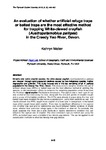An evaluation of whether artificial refuge traps or baited traps are the most effective method for trapping White-clawed crayfish (Austropotamobius pallipes)
| dc.contributor.author | Walter, K. | |
| dc.date.accessioned | 2019-05-15T14:03:27Z | |
| dc.date.available | 2019-05-15T14:03:27Z | |
| dc.date.issued | 2012 | |
| dc.identifier.citation |
Walter, K. (2012) ' An evaluation of whether artificial refuge traps or baited traps are the most effective method for trapping White-clawed crayfish (Austropotamobius pallipes)', The Plymouth Student Scientist, 5(2), p. 443-485. | en_US |
| dc.identifier.issn | 1754-2383 | |
| dc.identifier.uri | http://hdl.handle.net/10026.1/13997 | |
| dc.description.abstract |
Britain’s only native crayfish species, the white-clawed crayfish Austropotamobius pallipes are threaten through rapid population declines caused by non-indigenous species, habitat degradation and pollution. This study focuses one of the last remaining small A. pallipes population in the Creedy Yeo River, Devon. This study aims to decipher whether the use of artificial refuge traps (ARTs) or baited traps are the most effective method of catching this species, to aid translocation efforts to conserve the remaining population under threat from the American signal crayfish Pacifastacus leniusculus. The capture rate of each type of trap was studied at four sites along the river, along with the size and gender of crayfish caught and a survey of the habitat conditions. The ARTs were already in place along the river and baited traps were installed the day before a translocation, using fresh sardines as bait. The results showed that ARTs caught more crayfish of a lower size in comparison to the baited traps which caught large adult crayfish. There was no significant difference in the capture rate of either trap type and no relationship was found between habitat variables of shade cover, siltation level and main refuge types in the riverbank or channel. To conclude, this study suggests that there are a wide multitude of factors determining condition that can influence the capture rate of crayfish. The most consistent capture method was using the ARTs, as baited traps were unreliable in low density populations. This can be applied to aid conservation methods in other low density river populations. | en_US |
| dc.language.iso | en | en_US |
| dc.publisher | University of Plymouth | |
| dc.rights | Attribution 3.0 United States | * |
| dc.rights.uri | http://creativecommons.org/licenses/by/3.0/us/ | * |
| dc.subject | crayfish | en_US |
| dc.subject | white-clawed crayfish | en_US |
| dc.subject | Austropotamobius pallipes | en_US |
| dc.subject | native crayfish species | en_US |
| dc.subject | non-indigenous species | en_US |
| dc.subject | artificial refuge traps | en_US |
| dc.title | An evaluation of whether artificial refuge traps or baited traps are the most effective method for trapping White-clawed crayfish (Austropotamobius pallipes) | en_US |
| dc.type | Article | |
| plymouth.issue | 2 | |
| plymouth.volume | 5 | |
| plymouth.journal | The Plymouth Student Scientist |



